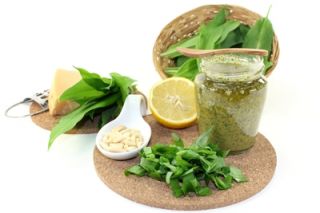
The lovely woods around our part of Surrey are somewhat whiffy at the moment. This is due to the vast carpets of wild garlic that thickly cover the woodland floor, relieved here and there by bluebells gently shaking their delicate heads as if tutting at the pungent aroma all around.
Well, the bluebells may not be so approving, but wild garlic is a terrific ingredient for those of us who like to cook fresh, seasonal food.
Also known as “Ramsons”, wild garlic is part of the Allium family, and is related to chives, onions and leeks. It thrives in damp, shady areas; look for its smooth, shiny leaves under trees, in hedgerows and on riverbanks. The woods where I walk are full of these deliciously fragrant plants, whose pretty white blooms will soon be a welcome treat after the impressive carpets of bluebells have faded.
Wild garlic leaves are easy to gather and a great excuse for a country stroll. And it’s immensely satisfying to return home clutching a bag stuffed with fresh spring greens that haven’t cost a penny. You need to pick them before the plant flowers (I tend to select leaves from lots of plants, rather than denuding just a few), as they soon die down and lose their vibrancy. The leaves offer a flavour that is milder than that of the cultivated garlic bulbs that I usually cook with, and don’t leave a lingering odour on the breath.
Once the leaves have faded, all is not lost - the flowers are edible, generally providing a more robust flavour. The bulbs are stronger still, and are best harvested when the plant is dormant from mid-summer, but they are very small and tricky to harvest. I confess I have not yet bothered. For me, the leaves are the most attractive proposition – easy to gather, and plentiful and nutritious at this time of year.
It’s not difficult to forage for wild garlic, due to its abundance and distinctive smell (especially when crushed or bruised), but do be careful not to confuse it with poisonous Lily of the Valley. It’s worth taking along a photograph to help with identification. As with any kind of foraging: if in doubt, don’t.
Once you’ve gathered and washed your garlic leaves, experiment by using them in lots of different ways. Chop and add to soups, stews, salads and sandwiches, or mix with cottage or cream cheese and serve with baked potatoes. Try using them in place of basil leaves in homemade pesto or simply wilt them and serve as a vegetable, in much the same way as spinach. They taste great in omelettes, and have a natural affinity with their cousin, the leek (try them baked with thinly-sliced potatoes, leeks and a milk/cream mixture for a hearty vegetarian supper). If you don’t want to use them straightaway, they will keep in a bag in the hydrator drawer of your fridge for a couple of days.
A favourite spring recipe in our house is Wild Garlic and Nettle Soup. I always think it’s perfect seasonal fair to help “spring clean” the system and deliver a tasty dose of antioxidants. There are plenty of young nettles in our woods, conveniently growing near the garlic, and they’re just as easy to gather – but remember to take a pair of scissors, a large bag and gloves to protect from stings. My daughter and I like making this soup on a sunny day – first of all we go to the woods with our little dog to collect our oh-so-local greens, then rush home and turn them into a broth that tastes all the more delicious because of all the fresh air, exercise and fun that has gone into making it. And you simply can’t compare that to opening a tin from the supermarket!
Try it: wild garlic and nettle soup recipe
Tags:

